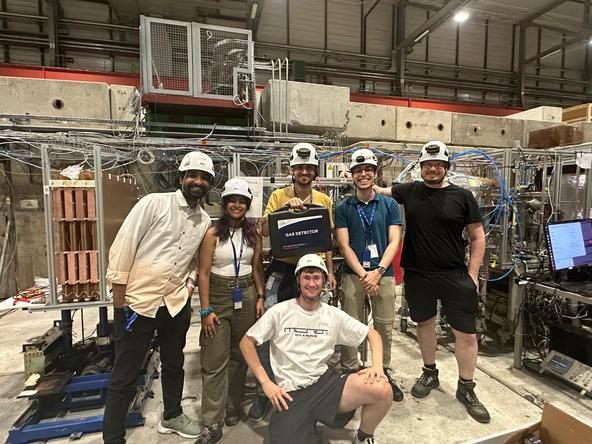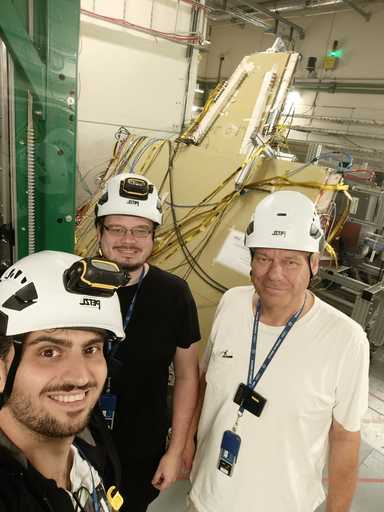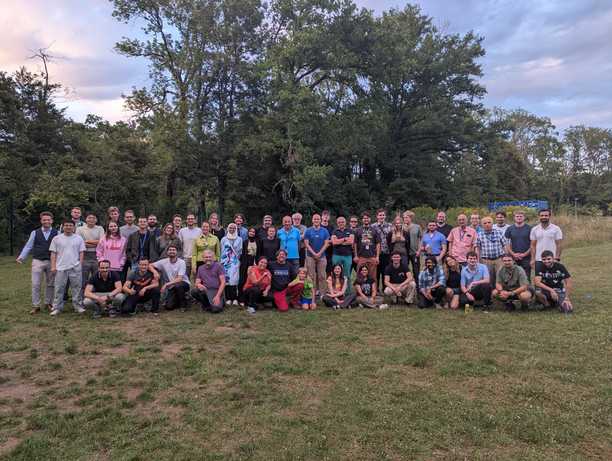2025 Beamtime @ CERN
The LMU particle physics group joined a Beamtime at CERN's SPS
14.07.2025 – 30.07.2025
From July 14th to 30th, 2025, researchers from LMU Munich participated in an intensive and productive beamtime at CERN's SPS H4 beamline, contributing to two distinct experiments. Represented by Dr. Fabian Vogel, Dr. Valerio D'Amico, Eshita Kumar, Nick Schneider, Daniel Grewe, Nirmal Mathew, and Dr. Ralf Hertenberger, the LMU team gained valuable insights into detector performance and operational principles across both setups.
Experiment 1: Detector R&D within the DRD1 Collaboration

Photograph of the Beamtime team in the beamline area. Photo: D.Grewe.
As part of the DRD1 collaboration, the LMU group took part in a large-scale test of novel detector technologies using a high-resolution tracking telescope. The detectors tested included:
- Charge-sharing pixel detectors
- Cherenkov-Micromegas hybrid detector
- SGR-Micromegas (Segmented GEM Readout)
- SGR-Triple GEM (Segmented GEM Readout)
- Two large-area (20×20 cm²) Triple GEM detectors
These detectors were exposed to 120 GeV muons and pions, enabling high-quality performance studies under beam conditions. The test beam led to extensive data acquisition and a deeper understanding of the detectors’ working principles. This experimental work will feed directly into several academic theses of all the PhD and Master students that joined the effort. Look out for results in the Master's theses of Nirmal Mathew (Pixel detector) and Daniel Grewe (Cherenkov and SGR), and the PhD theses of Eshita Kumar (Pixel detector) and Nick Schneider (Large-area GEMs).
The team extends its sincere thanks to the DRD1 collaboration for the opportunity to participate. Special acknowledgments go to Karl Floethner, Eraldo Oliveri, and Yorgos Tsipolitis for their excellent organization and continuous support throughout the beam period.
Experiment 2: ATLAS NSW Micromegas Testing at GIF++
In parallel, a spare New Small Wheel (NSW) Micromegas module of the ATLAS detector was tested at CERN’s GIF++ facility, where it was subjected to a controlled gamma background from a 12 TBq 137Cs source. The focus of this study was to improve the performance of the LM2 Micromegas modules under inclined particle incidence of the 120 GeV muons—conditions similar to those in the ATLAS underground cavern. Key objectives included:
- Tuning of the readout electronics configuration
- Studying alternative reconstruction algorithms
- Beginning the first implementation of a trigger scheme identical to the one planned for the Phase II upgrade of the NSW
This work was carried out in collaboration with Dr. Simone Francescato and Ioannis Mesolongitis concerning the trigger setup, with support from Michaela Arampatzi and Nikolaos Kanellos regarding the NSW Detector Control System (DCS).

Photograph in front of the inclined LM2 and SM1 NSW Micromegas inside the GIF++ facility. Photo: V. D'Amico.
Beamtime Conclusion
As per tradition, the beamtime wrapped up with a joint barbecue bringing together the teams from both GIF++ and the DRD1 test beam. Despite the intensity and long hours, the beam period was marked by successful data collection, promising results, and strong collaboration.
The LMU team expresses heartfelt thanks to all collaborators, organizers, and new colleagues met along the way. With valuable physics insights in hand, the team is already looking forward to the next test beam.

Participants of the joint barbecue to celebrate the end of the test beam. Photo: DRD1 Collaboration/GIF++.

